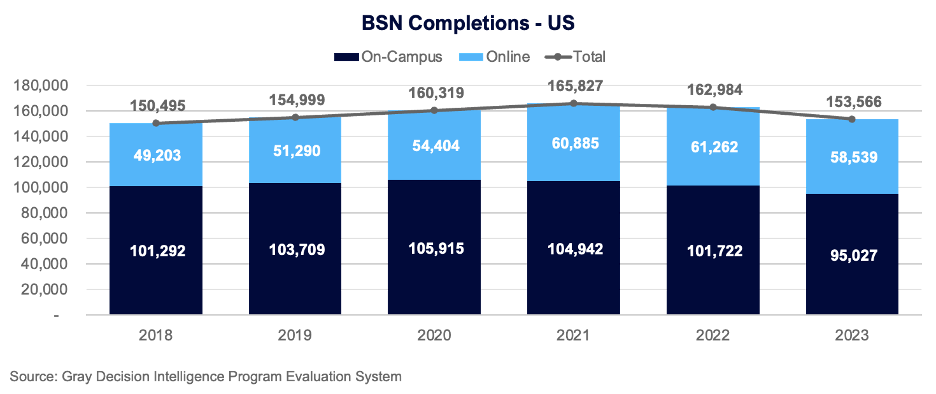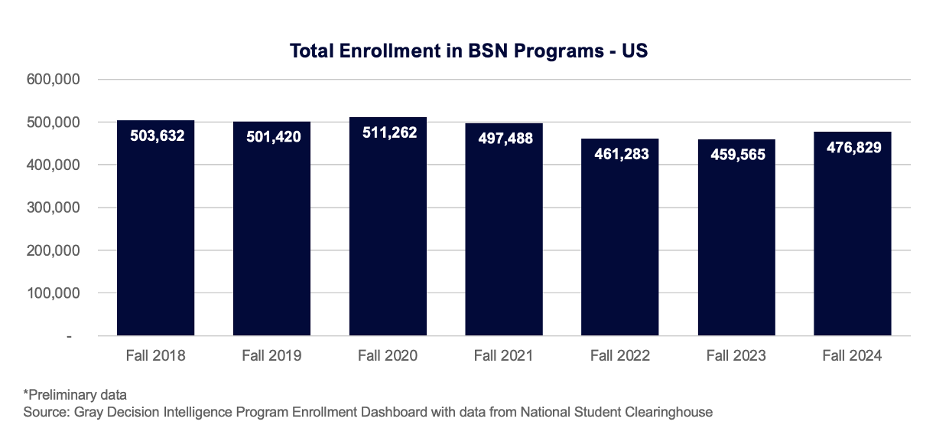“Nursing is a progressive art such that to stand still is to go backwards.” – Florence Nightingale, the founder of modern nursing.
Nurses are the lifeblood of the American healthcare system. In recent years, there has been a noticeable shift in the nursing industry, as the demand for BSN-trained nurses has dramatically increased. A 2022 study by the University of Pennsylvania Leonard Davis Institute of Health Economics indicates that nurses with BSN degrees are associated with better patient outcomes, including shorter hospital stays, fewer re-admissions, lower mortality rates, fewer medication errors, lower patient cost, and higher patient satisfaction.
The study goes on to say:
“Specifically, we found that every 10% increase in the proportion of BSN nurses in a hospital resulted in a 5.5% decrease in surgical patient mortality. This means that hospitals with 80% of the nursing staff holding a BSN by any pathway have mortality rates about 25% lower than hospitals with 30% of their nurses with BSN qualifications.”
Given evidence of better outcomes, it makes sense that according to the American Nurses Association, many hospitals actively seek nurses with BSN degrees. In 2017, New York State enacted the “BSN in 10” law, requiring nurses to complete a baccalaureate degree within ten years of becoming registered nurses. The law was created based on evidence that positive patient outcomes are much more likely to result from care given by baccalaureate-prepared nurses. Many states are expected to follow New York’s lead.
All BSN Pathways Lead to Better Outcomes
The University of Pennsylvania LDIH study found that “it does not matter whether nurses obtain their BSN through a traditional 4-year program at a college or university or an RN to baccalaureate completion program; all paths leading to a predominantly bachelor’s qualified hospital nurse workforce contribute to better patient outcomes.”
This is especially relevant as “any pathway” includes RN-to-BSN programs, which have become extremely popular. Flexible, often online, RN-to-BSN programs enable working nurses to complete a BSN without sacrificing their livelihoods or time with their families. Perhaps even more importantly, the flexibility of these programs allows RNs to stay in the nursing workforce, where they are very much needed.
Are BSN Graduates Keeping Pace with Demand?
While employer interest in BSN programs may be on the rise, student demand for BSN programs may not be keeping pace, at least on the surface. Data from Gray DI’s Program Evaluation System shows that the number of BSN graduates dropped for the second year in a row in 2023 after years of steady growth.

Maybe more concerning, the number of students enrolled in BSN programs has dropped off in recent years from previous highs, although enrollment ticked up again this past fall. Interestingly, according to the AACN, the most significant drop has been in RN-to-BSN completion programs; entry-level nursing programs are holding steady.

On the surface, a weakening or flattening of BSN program completions and enrollments after years of steady growth seems to indicate a decline in student interest, but the root cause may have more to do with capacity than demand. Persistent nursing faculty shortages and budget cuts appear to be contributing to the problem. Faculty shortages affect not only the classroom but also preceptorship at clinical placement sites; budget cuts decrease the availability of classroom spaces and clinical placement sites.
The AACN has expressed concern over the large number of qualified applications being turned away from four-year colleges and universities. In 2023, 55,111 qualified applications were turned away from entry-level BSN programs. Alarmingly, nearly 10,000 qualified applications for graduate-level programs were turned away in 2023. This is deeply concerning in terms of educating much-needed nursing faculty going forward.
Can Nursing Nurse Itself Back to Health?
“Let us never consider ourselves finished nurses. We must be learning all of our lives.”– Florence Nightingale
Many efforts are being made to alleviate these challenges to the nursing industry. Reducing the strain on nurses themselves by offering more flexible programs and pathways to degree completion is paramount. In an effort to boost enrollment, some institutions are offering flexible start dates. Others are partnering with community colleges. Many schools are now offering online, hybrid, and part-time options. Accelerated program options are also becoming more available, and are particularly attractive to nursing students who are keen to enter the workforce as soon as possible. The AACN has also urged all nursing schools to participate in the centralized application service NursingCAS, which alerts students to open slots at nursing schools.
Nurses take care of us. How can we take better care of them?




